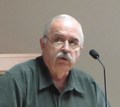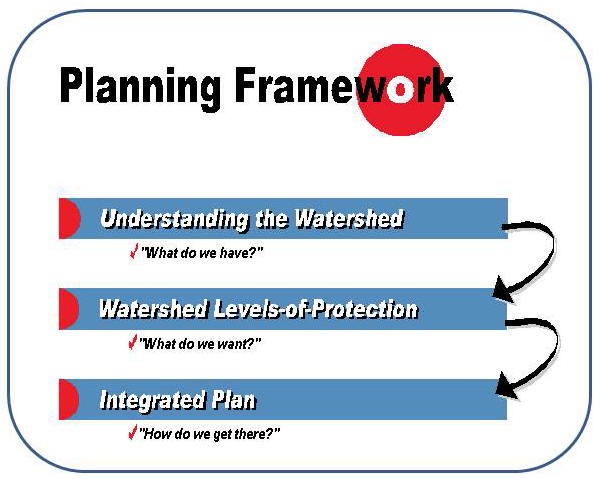Integrated Rainwater Management: Municipalities Can Achieve More With Less
Note to Reader:
On April 7, Metro Vancouver will host the 2011 Water Balance Model Partners Forum. This is an opportunity for local governments to learn from each other, and reflect on what can be accomplished through alignment and collaboration. The Water Balance Model is an outcome of collaboration.
The Partners Forum is part of the continuing rollout of Beyond the Guidebook 2010: Implementing a New Culture for Urban Watershed Protection and Restoration in British Columbia. To download a copy of the Draft Agenda, click here.
The Partners Forum will be conducted as an interactive sharing, learning and consultation session. Town-hall sharing segments will address three topics:
- The Plan for the Future: Are You Curious About the Water Balance Model Enhancement Program?
- Water Balance Model Express for Homeowners: How Would This Tool Help Your Municipality Influence Rainwater Management and Water Conservation Practices?
- Watershed-Based Planning: North Vancouver District Demonstrates How to Implement the “ISMP Course Correction”
This article is the fourth in a series that foreshadow the information-transfer that will take place at the Forum. The focus of the artlcle is on the ISMP Course Correction. It describes the drivers for doing business differently; provides an overview of how the times have changed; and introduces the precedent-setting Bowker Creek Blueprint. The time is now right to make the vocabulary change to IRMP from ISMP, where IRMP is the acronym for Integrated Rainwater Management Plan.
To download a PDF version of the article below, click on Integrated Rainwater Management: Municipalities Can Achieve More With Less .
ISMP Course Correction
A decade ago, local governments were venturing into uncharted waters when undertaking ISMPs, the acronym for Integrated Stormwater Management Plans. Now, the experience of the Bowker Creek Initiative (in the Capital Region) serves as a guide for the “ISMP Course Correction” in the Metro Vancouver region.
The need for a ‘course correction’ was identified by the Metro Vancouver Liquid Waste Management Reference Panel in its Final Report to the Metro Vancouver Board, released in July 2009: “Re-focus Integrated RAINwater/Stormwater Management Plans on watershed targets and outcomes so that there are clear linkages with the land use planning and development approval process.”
Regulatory Commitments
During the period November-December 2010, the Water Sustainability Action Plan for British Columbia released a 5-part series about considerations driving a course correction in the way ISMPs are undertaken. Release of the Summary Report for ISMP Course Correction Series followed in February 2011.
 “The purpose of the Summary Report is to guide those about to embark upon an ISMP process. The Partners Forum provides a platform for launching an educational program that will support implementation of the ISMP Course Correction in Metro Vancouver. This will help municipalities fulfil their regulatory commitments under the region’s Integrated Liquid Waste and Resource Management Plan,” states Ted van der Gulik, Chair of the Water Balance Model Partnership.
“The purpose of the Summary Report is to guide those about to embark upon an ISMP process. The Partners Forum provides a platform for launching an educational program that will support implementation of the ISMP Course Correction in Metro Vancouver. This will help municipalities fulfil their regulatory commitments under the region’s Integrated Liquid Waste and Resource Management Plan,” states Ted van der Gulik, Chair of the Water Balance Model Partnership.
“Each document in the ISMP Course Correction Series corresponds to an action. Taken together, the five actions comprise a recommended framework for a watershed-based planning process.” (Refer to image above for the five actions.)
Why the Course Correction
“There are two main drivers for the ISMP Course Correction,” continues Richard Boase, Partnership Co-Chair. “First, we had observed that too many stakeholders were either unaware or had lost sight of the original purpose in developing an ISMP – which is to  protect stream health. They had also lost sight of what integration means. The second significant driver is the ‘unfunded infrastructure liability’. Local governments are hard-pressed financially. Communities cannot afford the cost of traditional ‘pipe-and-convey’ drainage infrastructure. We are being asked to do more with less.”
protect stream health. They had also lost sight of what integration means. The second significant driver is the ‘unfunded infrastructure liability’. Local governments are hard-pressed financially. Communities cannot afford the cost of traditional ‘pipe-and-convey’ drainage infrastructure. We are being asked to do more with less.”
“Local governments in British Columbia are faced with this challenge: the initial capital cost of infrastructure is about 20% of the life-cycle cost; the other 80% largely represents a future unfunded liability. Fiscal constraints provide a powerful impetus for doing business differently to ‘achieve more with less’.”
A Powerful Tool
“An ISMP is a potentially powerful tool. It can influence other municipal processes for the better. It can generate the blueprint for integrated and coordinated action at a watershed scale,” adds Richard Boase. “This is the significance of the Bowker Creek Blueprint in the Capital Regional District. The four partner local governments —Capital Regional District, Victoria, Saanich and Oak Bay — now have a game plan for watershed redevelopment over the next 100 years.”
“The 4-stage process developed by the City of Surrey is presented in the Summary Report for the ISMP Course Correction Series. This summary of lessons learned by those who have developed watershed-based plans can help those about to embark on an ISMP process. The notion of ‘shared responsibility’ is a foundation piece for collaboration, alignment and integration,” concludes Richard Boase.
City of Surrey Framework
The City of Surrey has a guiding philosophy which is summarized below. These four principles establish expectations:
- Recognize that each watershed area is unique, and its needs are unique.
- Integrate drainage planning with land use, environment, parks, and other infrastructure/community needs.
- Model the drainage system after there is some concept of overall direction – do not model just to model.
- Have short, medium and long term goals / visions for the ISMP area, complete with integration of opportunities.
An Integrated Rainwater Management Plan (IRMP) should provide a clear picture of how local governments can apply land use planning tools to create a future watershed condition desired by all. This approach contrasts with a conventional ISMP approach where the primary emphasis is on data collection, computer modeling and pipe analyses; and results in an enhanced Master Drainage Plan.
To download a copy of the aforementioned Table 2, click on City of Surrey Framework for an Holistic and Balanced ISMP.
To Learn More:
 For more information on the 5-part series, click on Water Bucket publishes excerpts from “Beyond the Guidebook 2010″ about why and how to re-focus ISMPs on outcomes — “Outcome-oriented planning is a problem-solving PROCESS. It is not a procedure. It is not a matter of applying a regulation or a checklist. Participants have to be committed to the outcome,” states Tim Pringle, President of the Partnership for Water Sustainability in British Columbia.
For more information on the 5-part series, click on Water Bucket publishes excerpts from “Beyond the Guidebook 2010″ about why and how to re-focus ISMPs on outcomes — “Outcome-oriented planning is a problem-solving PROCESS. It is not a procedure. It is not a matter of applying a regulation or a checklist. Participants have to be committed to the outcome,” states Tim Pringle, President of the Partnership for Water Sustainability in British Columbia.
 Click on Application of the “DFO Urban Stormwater Guidelines” has evolved over the past decade to protect stream health — “The objective of protecting stream health is broader than how much volume one can infiltrate on a particular development,” emphasizes Corino Salomi, Area Manager, Oceans, Habitat & Enhancement Branch, Lower Fraser Area.
Click on Application of the “DFO Urban Stormwater Guidelines” has evolved over the past decade to protect stream health — “The objective of protecting stream health is broader than how much volume one can infiltrate on a particular development,” emphasizes Corino Salomi, Area Manager, Oceans, Habitat & Enhancement Branch, Lower Fraser Area.
What We Have Learned After a Decade
 “The genesis for ISMPs was a desire to integrate the community, engineering, planning and environmental perspectives. The implicit goal was to build and/or rebuild communities in balance with ecology. Local governments knew they had to do business differently in order to protect and/or restore watershed health,” states Robert Hicks, Senior Engineer in the Policy & Planning Division at Metro Vancouver. He has been involved in the ISMP process from the beginning.
“The genesis for ISMPs was a desire to integrate the community, engineering, planning and environmental perspectives. The implicit goal was to build and/or rebuild communities in balance with ecology. Local governments knew they had to do business differently in order to protect and/or restore watershed health,” states Robert Hicks, Senior Engineer in the Policy & Planning Division at Metro Vancouver. He has been involved in the ISMP process from the beginning.
 “Now, the ‘unfunded infrastructure liability’ is a driver for local governments to consider longevity, focus on what happens after developers hand-off municipal infrastructure, get it right at the front-end, and prepare for the future,” continues Glen Brown, Executive Director with the Ministry of Community, Sport and Cultural Development. His responsibilities encompass local government infrastructure and finance.
“Now, the ‘unfunded infrastructure liability’ is a driver for local governments to consider longevity, focus on what happens after developers hand-off municipal infrastructure, get it right at the front-end, and prepare for the future,” continues Glen Brown, Executive Director with the Ministry of Community, Sport and Cultural Development. His responsibilities encompass local government infrastructure and finance.
Sustainable Service Delivery
 “Tackling the unfunded infrastructure liability requires a life-cycle way of thinking about infrastructure needs, in particular how to pay for those needs over time. This holistic approach is described as Sustainable Service Delivery,” states Wally Wells, Coordinator for Asset Management BC.
“Tackling the unfunded infrastructure liability requires a life-cycle way of thinking about infrastructure needs, in particular how to pay for those needs over time. This holistic approach is described as Sustainable Service Delivery,” states Wally Wells, Coordinator for Asset Management BC.
 “The paradigm-shift starts with land use planning. Connecting the dots between watershed health and infrastructure type is emerging as an important piece in ‘sustainable drainage infrastructure’, both fiscally and ecologically,” emphasizes Kim Fowler, Director of Sustainability with the City of Victoria (and a member of the Local Government Asset Management Working Group).
“The paradigm-shift starts with land use planning. Connecting the dots between watershed health and infrastructure type is emerging as an important piece in ‘sustainable drainage infrastructure’, both fiscally and ecologically,” emphasizes Kim Fowler, Director of Sustainability with the City of Victoria (and a member of the Local Government Asset Management Working Group).
 “The financial burden and environmental impacts associated with ‘pipe-and-convey’ infrastructure contrast with the benefits of ‘green’ infrastructure at a watershed scale: natural landscape-based assets reduce runoff volumes, have lower life-cycle costs, decrease stresses applied to creeks, and enhance urban liveability,” continues Ray Fung, Chair of the Green Infrastructure Partnership.
“The financial burden and environmental impacts associated with ‘pipe-and-convey’ infrastructure contrast with the benefits of ‘green’ infrastructure at a watershed scale: natural landscape-based assets reduce runoff volumes, have lower life-cycle costs, decrease stresses applied to creeks, and enhance urban liveability,” continues Ray Fung, Chair of the Green Infrastructure Partnership.
 “Level-of-service is the integrator for everything that local governments do. Everyone will have to make level-of-service choices. Thus, a guiding principle for a watershed-based plan could be framed this way: Establish the level-of-service that is fiscally sustainable AND protects watershed health,” concludes John McMahon, Chair of Metro Vancouver’s Stormwater Interagency Liaison Group.
“Level-of-service is the integrator for everything that local governments do. Everyone will have to make level-of-service choices. Thus, a guiding principle for a watershed-based plan could be framed this way: Establish the level-of-service that is fiscally sustainable AND protects watershed health,” concludes John McMahon, Chair of Metro Vancouver’s Stormwater Interagency Liaison Group.
About the Bowker Creek Blueprint
 “The Bowker Creek Initiative is a unique multi-jurisdictional effort. Four local governments, community groups, post-secondary institutions and private citizens are collaborating to improve the health of Bowker Creek and its watershed,” reports Jody Watson, Harbours and Watersheds Coordinator with the CRD. She is the Chair of the Bowker Creek Initiative.
“The Bowker Creek Initiative is a unique multi-jurisdictional effort. Four local governments, community groups, post-secondary institutions and private citizens are collaborating to improve the health of Bowker Creek and its watershed,” reports Jody Watson, Harbours and Watersheds Coordinator with the CRD. She is the Chair of the Bowker Creek Initiative.
“The BCI developed the Bowker Creek Blueprint through a knowledge-based approach. The regional team convened as an inter-disciplinary roundtable to synthesize their individual areas of knowledge. Drainage, land use, environmental and social information was compiled and assessed in an holistic way that enabled team members to apply their collective best judgment, reach-by-reach.”
“We now have a 100-Year Action Plan to guide watershed and creek restoration as the various neighbourhoods redevelop over time. Having an Action Plan in place will ensure that positive changes can happen incrementally, and that opportunities for major improvements can be realized as they arise,” concludes Jody Watson.
Achieve More With Less
 “The elephant in the room is always money. Municipalities have lots of competing interests for spending money; lots of projects to keep staff busy; and finite financial resources. We are all challenged to do more with less and get it done,” stated Anne Topp, District of Saanich Manager of Community Planning, at the 2010 Bowker Creek Forum.
“The elephant in the room is always money. Municipalities have lots of competing interests for spending money; lots of projects to keep staff busy; and finite financial resources. We are all challenged to do more with less and get it done,” stated Anne Topp, District of Saanich Manager of Community Planning, at the 2010 Bowker Creek Forum.
“We all have heard the quote ‘if you don’t know where you are going, it doesn’t matter what road you take’. With completion of the Blueprint, the Bowker Creek Initiative knows where it wants to go. Integrating with and using other plans to advance the Blueprint will be ongoing.”
“The 100-year Action Plan gives us time. This plan is not just about water. It is about how this community wants to live and connect to the environment. We don’t have to do the $20 million, $40 million ISMP approach. Keeping the pieces small and creating bite-sized pieces should allow the slow and steady approach,” concludes Anne Topp.
Transferability to Metro Vancouver
“The District of North Vancouver is adapting the Bowker Creek Initiative’s outcome-oriented approach and applying the City of Surrey’s framework to develop our first ISMP. We are learning from both,” states Richard Boase. He is the District’s project manager. “The Bowker Creek Blueprint has demonstrated the payback in applying a knowledge-based approach to focus on solutions and outcomes. Surrey has more ISMP experience than any other jurisdiction in BC. We are blending our vision for restoring the rainfall capacity of the District of North Vancouver’s watershed, one property at a time, into the ISMP mix.”
“The District’s Official Community Plan Update is our opportunity to address the link between densification of single family lands and the health of the municipality’s streams. The proposed Lynn Valley Town Centre makes this tangible. We are drawing on our in-house resources to demonstrate what an inter-departmental approach can accomplish. To supplement our in-house capabilities, the District is collaborating with the University of British Columbia and the Partnership for Water Sustainability.”
“At the Partners Forum, I will elaborate on how the District of North Vancouver is already achieving more with less. Collaboration will save the District a lot of money, inform our vision for embedding a Watershed Landscape Restoration Strategy in the Official Community Plan Update, and fulfil our ISMP regulatory commitments.”
To Learn More:
 Click on The Bowker Creek Blueprint demonstrates what can be accomplished through a vision, alignment and collaboration — “Based on my experience over the past 30-plus years, the Bowker Creek Blueprint has gone well beyond any other plan in terms of how it has achieved consensus and galvanized commitment to move from planning to action on the ground,” states Kim Stephens, Executive Director of the Partnership for Water Sustainability.
Click on The Bowker Creek Blueprint demonstrates what can be accomplished through a vision, alignment and collaboration — “Based on my experience over the past 30-plus years, the Bowker Creek Blueprint has gone well beyond any other plan in terms of how it has achieved consensus and galvanized commitment to move from planning to action on the ground,” states Kim Stephens, Executive Director of the Partnership for Water Sustainability.
 Click on A crucially important message in Beyond the Guidebook 2010: “We now have the tools and experience to design with nature” — “So many in local government are searching for the magical ‘silver bullet’ to resolve watershed issues and challenges. Yet soil, vegetation and trees can do more for our watersheds than decades of planning, consulting and complicated engineering design will ever achieve,” states Richard Boase.
Click on A crucially important message in Beyond the Guidebook 2010: “We now have the tools and experience to design with nature” — “So many in local government are searching for the magical ‘silver bullet’ to resolve watershed issues and challenges. Yet soil, vegetation and trees can do more for our watersheds than decades of planning, consulting and complicated engineering design will ever achieve,” states Richard Boase.
Posted March 2011





